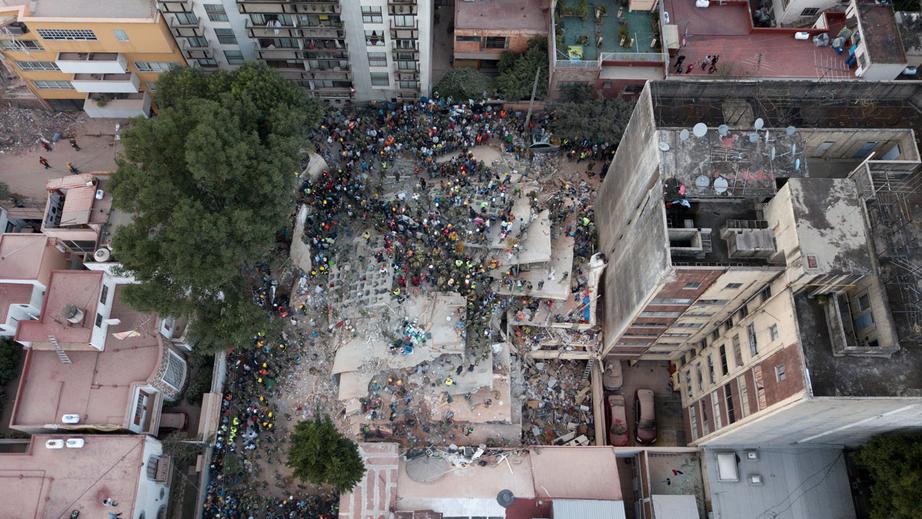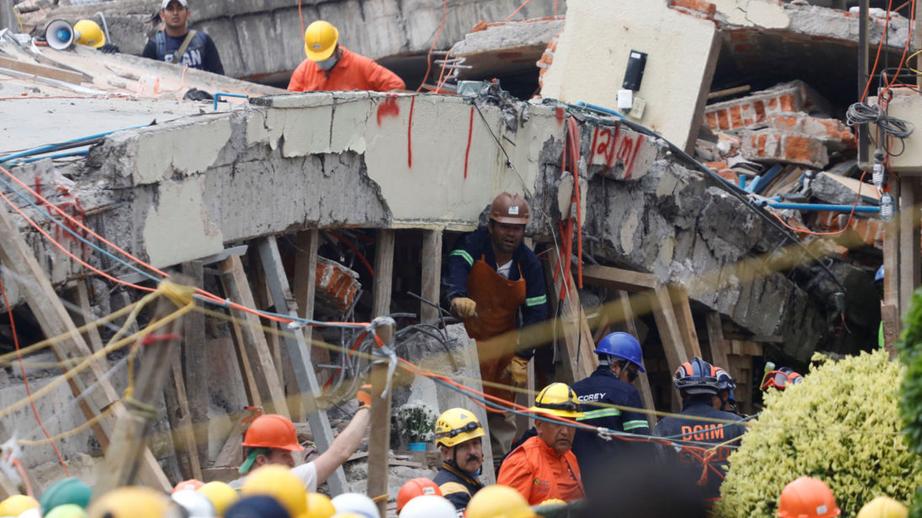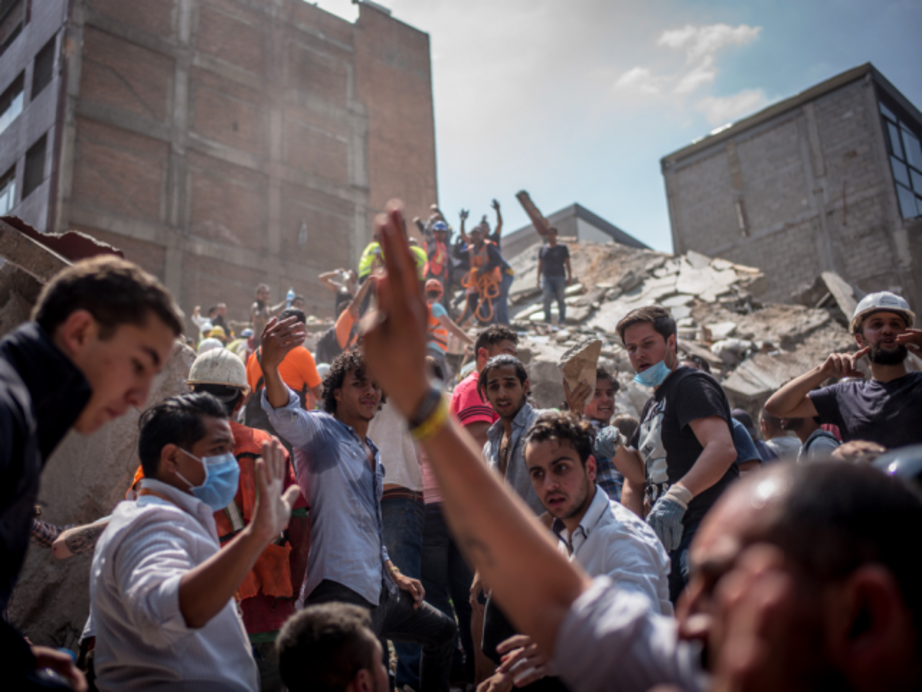Entire towns in Mexico flattened as scale of earthquake damage emerges
Thousands of left homeless in towns and communities outside Mexico City as official rescue and relief efforts struggle to cope with the widespread destruction
- Mexico earthquake: rescuers keep searching as death toll climbs to 250 – live
- Rescuers work to pull children from collapsed school in Mexico City

Hopes that rescuers will find more survivors trapped beneath collapsed buildings in central Mexico were fading on Thursday, as the scale of the devastation wreaked by the country’s deadliest earthquake for a generation started to become clear.
The death toll from Tuesday’s 7.1 magnitude quake rose to 273, including 137 in the capital, and was almost certainly set to rise as rescue workers continue to search the precarious ruins amid the threat of aftershocks, collapsing rubble and gas leaks.

Parts of Mexico City – which is built on a drained lakebed – were devastated in the quake which struck 32 years to the day after the country’s deadliest earthquake killed thousands and laid waste to the capital.
But details of the destruction outside the capital are only now starting to emerge, with reports of entire towns flattened and thousands of people left homeless.
Directly south of Mexico City in Morelos state, the death toll stands at 73. The damage was especially acute in the municipality of Jojutla, where houses were reduced to rubble.
“Jojutla is damaged badly, but there are communities that have suffered the same or worse,” said Óscar Cruz, a spokesman with the local Catholic diocese, who added all 89 Catholic parishes in the state suffered damage. “What’s tragic is that the damage is worst in the poorest pueblos.”
The office of president Enrique Peña Nieto said there were also 73 deaths in Morelos state, 43 in Puebla, 13 in the State of Mexico, six in Guerrero and one in Oaxaca.
In Puebla state, authorities have declared a state of “extraordinary emergency” in 112 municipalities – equivalent to 51% of the region.
At least 1,700 homes have been declared uninhabitable and should be demolished over coming months, according to the state governor. The number could well rise after experts finish more exhaustive inspections.
In Metepec, a quaint colonial town, almost every house and business has suffered structural damage, raising fears among residents that the rebuild could take years.
Calls for urgent help and supplies in towns and communities outside the capital continue to be posted on social networks as official rescue and relief efforts struggle to cope with the widespread destruction.
Hopes that survivors could still be found have been boosted by round-the-clock coverage of the navy-led search for a 12-year-old girl believed to be trapped under a collapsed school in the south of Mexico City.
But contradictory reports from the scene have led to confusion and anger towards the country’s main broadcasters for peddling false hope and neglecting the rest of the quake’s victims.
According to the broadcaster Televisa, all students with that name at the school had been accounted for, while the public education secretary Aurelio Nuño said that the girl’s parents had not been located.
In the hours after the quake struck, 11 other children were rescued from the Enrique Rebsamen School, but 21 children and five adults have been found dead so far.
For two days, the country was captivated by the story of the girl, identified as Frida Sofia, as TV networks and authorities repeatedly reported that her rescue was imminent.
But as the hours passed without progress, confusion and anger mounted amid contradictory reports from the scene; critics accused the country’s main broadcasters of peddling false hope and neglecting the rest of the quake’s victims.
On Thursday the navy announced that in fact there was no child under the rubble, but the rescue mission would continue as an adult survivor could still be trapped.
There was also growing anger at alleged attempts by the armed forces, which have taken over many of the rescue operations initially led by volunteers, and had started to raze collapsed buildings less than 72 hours after the earthquake – prompting fears that they could destroy buildings where survivors remained trapped.
In the trendy La Roma neighbourhood, the navy reportedly shut down a rescue operation in an office block on Thursday morning in order to start bulldozing the unstable structure from which 24 survivors had been pulled free.
The sobbing mother of one young woman trapped inside told Televisa “I will not let the navy bulldoze this building when my daughter and other people are still trapped inside and could be alive.”
Reports of clashes between volunteer rescue workers and the armed forces are also surfacing across the capital.
“The army has a history of imposing brutal triage rules for natural disasters which dates back to the 1985 earthquake,” said public policy analyst Rodolfo Soriano Nuñez. “They might get away with this arrogant approach in Oaxaca or Chiapas, but not in Mexico City.”
As cracks started to show in what has been until now lauded as a unified national response, extraordinary tales of survival continue to lift spirits.
Ashley Skoch, 29, was lying in bed watching TV on the sixth floor of a seven-storey apartment block in La Condesa that was toppled by the tremor.
Skoch, from Seattle, arrived in the city a few hours before the earthquake struck to visit a friend who had lived in the building for two years. She jumped up and ducked at the foot of the bed as the walls began to crack and the building “slid down like a layer cake”, she told the Guardian. It almost certainly saved her life.
“When I came to, my head was bleeding, a giant pillar had fallen onto the bed but I wasn’t trapped and could move my body. I was in shock but I put on my pants, grabbed my backpack and laptop and got myself out of the rubble and sat down.”
Nearby construction workers rushed to the scene of the collapsed building and used a crane to lift her to the ground. By this time, Skoch could barely stand, so a man carried her down the road and tried to stop the bleeding until an ambulance arrived and took her to a clinic, from where she was able to contact her friend. Skoch sustained a compound fracture to the spine, but should make a full recovery.
“I feel lucky, but can’t make sense of why I survived when so many others died or are still missing.”
For the rest of this article please go to source link below.
Video can be accessed at source link below.

